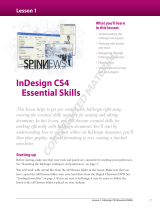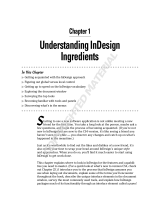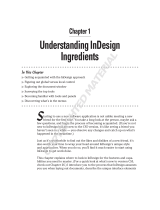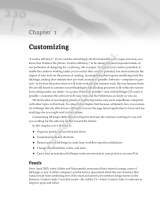
FreeHand to Illustrator Migration Guide—The Illustrator Workspace 12
T H E I L L U S T R A T O R W O R K S P A C E
All panels, including
the Control panel,
have a pop-up menu
that oers additional
tool options and panel
viewing options.
Panels can be collapsed into an icon
view to optimize your screen space.
The Application bar provides direct access
to Bridge, document viewing options, a full
selection of workspaces, and search.
The Control panel
e Control panel is context sensitive and oers quick access to options related to the
objects you select. For example, if you select a vector object, many controls you will need
to change its attributes appear there, including commands for precise positioning. You can
access anchor point controls, selection tools, clipping masks, envelope distortions, char-
acter attributes, and more, all exposed contextually so you can use the Control panel as your
primary tool for editing your artwork.
e Control panel also provides fast access to panels, which, in some cases, oer additional
options. Click a blue hyperlink to open another panel for easy access. To congure the
Control panel, choose options from the panel’s pop-up menu, also called the panel menu.
A. Click to close panel.
B. Click to show/hide panel options.
C. Click to collapse/expand panel height.
D. Click to show pop-up menu for the panel.
E. Click to collapse/expand panel width.
F. Creates a new iteration of the panel’s “subject,” such as an
action, brush, style, layer, or swatch. Option-click (Mac OS)
or Alt-click (Windows) to set options (except action and
brush). Drag onto button to duplicate action, brush, style,
layer, swatch, or appearance.
G. Deletes action, brush, style, layer, swatch, or appearance;
Option-click (Mac OS) or Alt-click (Windows) to delete
without confirmation (except in Variables panel).
Other panel shortcuts
styles, or swatches.
brushes, layers (same level), links, styles, or swatches.
Control panel.
Common panel actions
Panels
You can access all panels in Illustrator from the Window menu; some can
also be activated by clicking the blue hyperlinks in the Control panel.
A panel can be grouped with another by dragging its tab onto the other
panel. To dock panels so that they move together, drag a panel’s tab to
the bottom of another panel until you see a blue line. When the panels
are grouped or stacked in panes, they can be collapsed into an icon view
to further optimize the working space. Once you have organized the
panels, you can save your setup as a Workspace by choosing Window >
Workspace > Save Workspace.
The context-sensitive Control panel gives
you immediate access to formatting options
that pertain to your current selection.
F G
ECB
A D

























